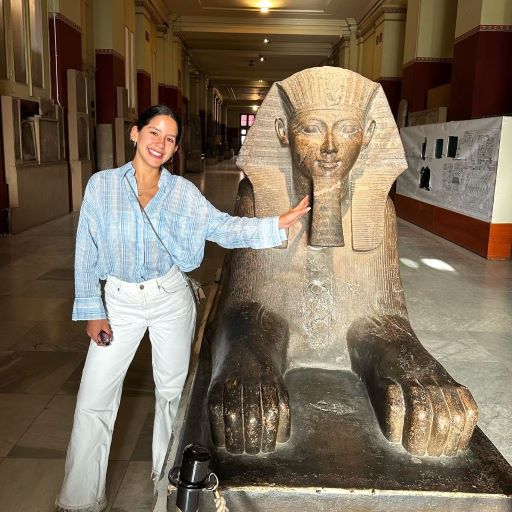The Giza Pyramids: A Testament to Ancient Egyptian Grandeur
The Giza Pyramids stand as an awe-inspiring testament to the ancient Egyptians’ architectural prowess and their enduring fascination with the afterlife. These monumental structures have captivated the imaginations of people around the world for millennia, and they continue to be a subject of study and admiration.
The Great Pyramid of Khufu
The largest and most famous of the Giza Pyramids is the Great Pyramid, built for Pharaoh Khufu. It is a marvel of engineering that was constructed using approximately 2.3 million blocks of stone, each weighing an average of 2.5 to 15 tons. The original height of the pyramid was 481 feet, making it the tallest man-made structure in the world for over 3,800 years.
The Pyramid of Khafre
The second pyramid at Giza, built for Khufu’s son Khafre, is slightly smaller but no less impressive. It includes the Sphinx, a colossal statue with the body of a lion and the head of a pharaoh, which has sparked countless debates about its origin and purpose. Khafre’s pyramid originally stood at 471 feet and was designed to serve as a beacon of the pharaoh’s power.
The Pyramid of Menkaure
The third pyramid, built for Khafre’s son Menkaure, is the smallest of the three but features complex internal structures and unique decorations. It was originally 218 feet tall and included a variety of temples and causeways that added to the grandeur of the site
The Pyramids of giza Construction and Labor
The construction of the Giza Pyramids is a testament to the organizational skills of the ancient Egyptians. It is believed that a workforce of thousands of skilled laborers, craftsmen, and engineers worked for decades to complete these structures. They lived in nearby temporary cities and were well-fed and cared for, contrary to the myth that they were slaves.
Giza pyramids Astronomical Alignment and Religious Significance
The alignment of the pyramids with the stars of Orion’s belt and their orientation to the cardinal points suggest that they had astronomical significance. The ancient Egyptians believed that the alignment would help the pharaohs’ souls ascend to the heavens and join the gods.
The Giza Pyramids Today
Today, the Giza Pyramids are a UNESCO World Heritage Site and one of the most popular tourist destinations in the world. They continue to be a source of inspiration and wonder, reminding us of the incredible capabilities of ancient civilizations.
Conclusion
The Giza Pyramids are more than just ancient monuments; they are symbols of human achievement and a bridge to our past. As we continue to unravel their mysteries, they will undoubtedly inspire future generations to reach for the stars, just as the ancient Egyptians did thousands of years ago.
This article provides a glimpse into the history and significance of the Giza Pyramids, exploring their construction, purpose, and legacy. I hope you find it informative and engaging!
Egypt Tours to Giza Pyramids
-
From $1440 🎗 10% OFFAswan, Cairo, Egypt, Luxor

 Sale! Add to cart
7 Days Deluxe Nile cruise + Domestic Flights
Sale! Add to cart
7 Days Deluxe Nile cruise + Domestic Flights7 Days Tour To Egypt with Cairo, Aswan, Luxor, and Nile Cruise
Rated 0 out of 5Nile Cruise$2,000.00$1,600.00Transporte
Guia turístico particular
Hospedagem
Restaurante
AC
Sun Deck-Bar
Discoteca
Piscina
Internet
Fax
Geladeira
Telefone
Chuveiro
Secador de cabelo
Seguro
TV
Biblioteca
-
From $990 🎗 10% OFFAbu Simbel, Aswan, Cairo, Egypt, Luxor

 Sale! Add to cart
6 Days Air-conditioned van + Domestic flights + Nile Cruise
Sale! Add to cart
6 Days Air-conditioned van + Domestic flights + Nile CruiseThe Perfect 6 Days Egypt Itinerary with Cairo and Nile Cruise
Rated 0 out of 5Cairo and Abu Simbel Tour packages$1,400.00$1,100.00Transporte
Guia turístico particular
Hospedagem
Restaurante
AC
Sun Deck-Bar
Discoteca
Piscina
Internet
Fax
Geladeira
Telefone
Chuveiro
Secador de cabelo
Seguro
TV
Biblioteca
-
From $1440 🎗 10% OFFAbu Simbel, Aswan, Cairo, Egypt, Luxor

 Sale! Add to cart
7 Days Deluxe Nile cruise + Domestic Flights
Sale! Add to cart
7 Days Deluxe Nile cruise + Domestic Flights7 Days Egypt Tour Package With Cairo and Nile Cruise
Rated 0 out of 5Nile Cruise$1,800.00$1,600.00AC
Sun Deck-Bar
Internet
Fax
-
From $1710 🎗 10% OFFAbu Simbel, Aswan, Cairo, Egypt, Luxor

 Sale! Add to cart
8 Days Deluxe Nile cruise + Domestic Flights
Sale! Add to cart
8 Days Deluxe Nile cruise + Domestic Flights8 Days Egypt Tour with Pyramids, Nile Cruise and Abu Simbel
Rated 0 out of 5Nile Cruise$2,300.00$1,900.00Transport
Private Tour Guide
Accommodation
Restaurant
AC
Sun Deck-Bar
Discotheque
Swimming pool
Internet
Fax
Fridge
Phone
Shower
Hairdryer
Safe
TV
Library
-
From $1710 🎗 10% OFFAbu Simbel, Aswan, Cairo, Egypt, Hurghada, Luxor

 Sale! Add to cart
10 days deluxe crucero por el Nilo + Vuelos Domésticos
Sale! Add to cart
10 days deluxe crucero por el Nilo + Vuelos Domésticos10 Days Egypt Tour Package to Cairo, Hurghada, Luxor, Aswan, and Nile Cruise
Rated 0 out of 5Cairo and Abu Simbel Tour packages$2,300.00$1,900.00Transport
Private Tour Guide
Accommodation
Restaurant
AC
Sun Deck-Bar
Discotheque
Swimming pool
Internet
Fax
Fridge
Phone
Shower
Hairdryer
Safe
TV
Library
-
From $2520 🎗 10% OFFAbu Simbel, Alexandria, Aswan, Cairo, Edfu, Egypt, Giza, Hurghada, Kom Ombo, Luxor

 Sale! Add to cart
16 Days Deluxe Nile cruise + Domestic Flights
Sale! Add to cart
16 Days Deluxe Nile cruise + Domestic Flights16 Days Egypt Tour with Nile Cruise, Pyramids and White Desert Safari
Rated 5.00 out of 5Nile Cruise$3,500.00$2,800.00Transport
Private Tour Guide
Accommodation
Restaurant
AC
Sun Deck-Bar
Discotheque
Swimming pool
Internet
Fax
Fridge
Phone
Shower
Hairdryer
Safe
TV
Library




